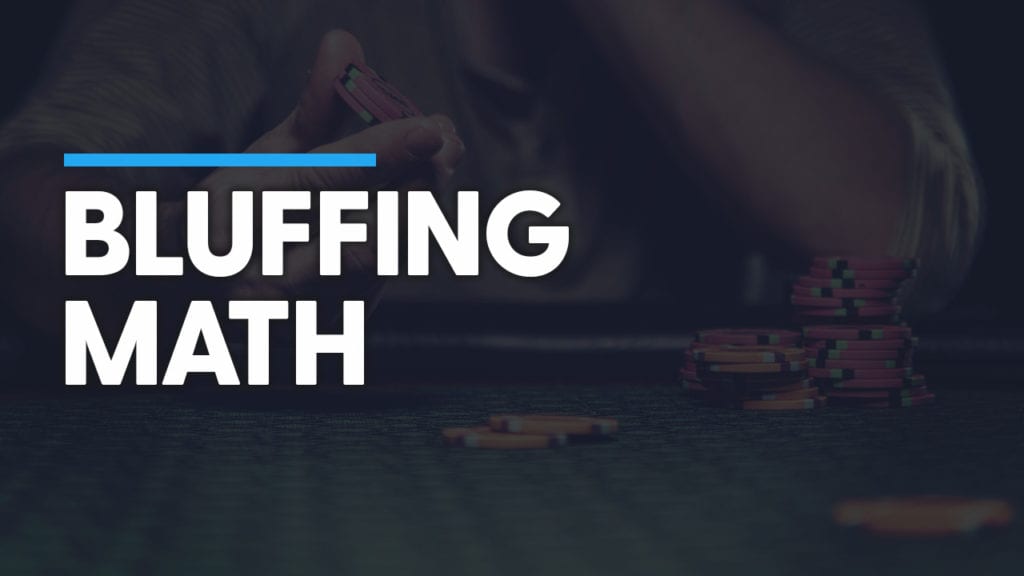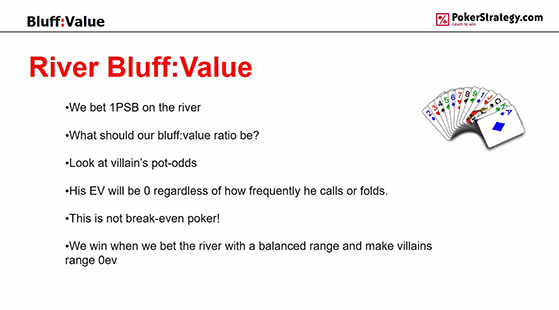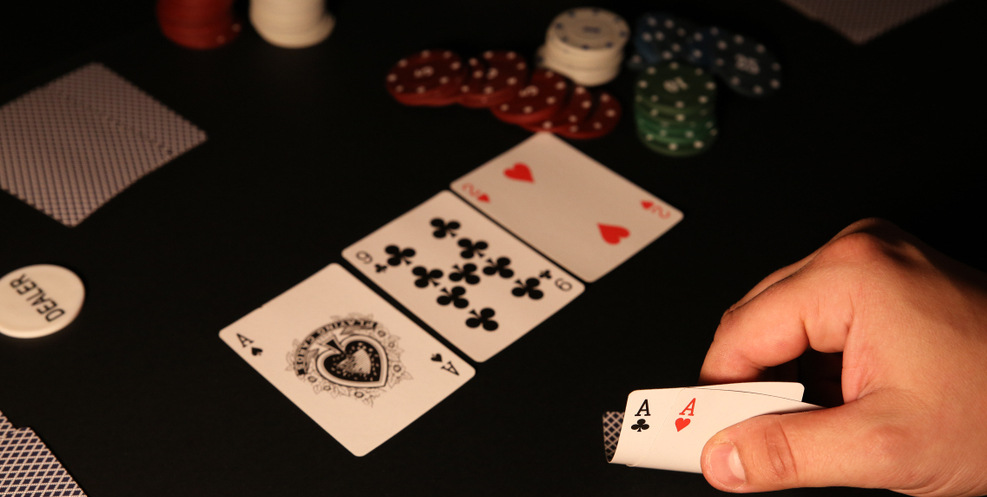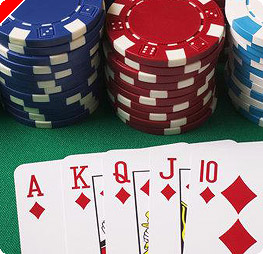- Poker Bluff Strategy Tactics
- Poker Bluffing Strategy
- Poker Bluff Strategy Games
- Poker Bluff Strategy Definition
- Poker Bluff Strategy Game
You’re sitting in the hijack at a 6-max No-Limit Hold’em poker cash table, playing online poker for real money at Ignition. Here come your hole cards: Eight-Four suited, both Hearts. Not exactly a premium hand – but you’re feeling spicy, so you open anyway. The big blind calls, and the flop comes King-Five-Three with two Hearts and a Club. You continuation bet, the big blind calls. Turn is a Nine of Clubs. You bet again, the big blind calls. River is a Six of Clubs. You’ve got absolutely nothing – but you go all-in! And your opponent folds in the game!
Congratulations: You just ran a sick poker bluff. There’s nothing quite like getting your opponent to fold and surrender all those chips when you’ve got a trash hand. In fact, if you want to be a winning poker player in the long run, you have to put moves like this in your arsenal. But as always, there’s a time to bluff and a time to just muck your cards in the game. This guide will show you what bluffing is all about, and how to develop poker bluffing strategies that will pay out handsomely in the long run.
What Is a Poker Bluff?
The word bluff is a familiar everyday term in the English language but it first came to us from the Netherlands. Its use can be traced back to 1791, and probably comes from the Dutch word bluffen, which means “to brag” or “to deceive.” The word bluffen was later applied to card games where players with a weak hand can trick their opponents into folding; in fact, brag itself was a British version of one of these games, a precursor of modern poker that was played in the 1700s.
- While it may seem fun to bluff all the time, it’s definitely not part of a winning strategy. Controlled and calculated bluffs can work wonders, though. Just remember to make sure that you are doing them at the right time, against the right opponents, and with the right image.
- Learning cash game strategy is essential if you want to be a professional poker player. Poker tournaments have extreme variance even when you are playing well, but cash games can provide a steady income.
- The semi-bluff is a hand that has potential to become the best hand once you get to the river but probably isn't the best hand at the start. While a straight bluff with a poor hand can be pulled off if you're up against a weak player prone to easy laydowns, a 'semi-bluff' can win you a hand in two ways.
- Four and Five Bluff Bet Strategy Matt VIP. 8,253 Views. Comments. on 4/7/16 Including a four and five bet bluff in your poker strategy seems risky but can pay off in many spots - read more here.
There are multiple ways to deceive your opponents in a poker game. For example, you can slowplay a strong hand and fool your opponent into thinking you’re weak but that’s not a bluff – it’s the opposite. Bluffing is specifically when you bet or raise with a weak hand, hoping to get your opponent to fold a stronger hand. And there are many different kinds of bluffs you can run at the poker table.

What Is a Pure Bluff?
Bluffs can be categorized by the players' strength, much like the standard poker hand ranking list from High Card to Royal Flush. The weakest of all bluffs is a pure bluff, also known as the naked bluff. This is when you bet or raise with a hand that doesn’t have any outs, meaning it can’t draw to a made hand that can beat your opponent in the game.
Malta Poker Festival Satellites, Round 3. A 3rd round of Malta Poker Festival satellites atIntertops Poker will be sending another winner to the world-class €500K Mediterranean poker tournament. $300 GTD PLO Fight Night - Omaha Bounty Tournament. New bounty tournament for Omaha players: $300 GTD PLO Fight Night at Intertops Poker & Juicy.
Of course, if you’re already on the river and you haven’t made your hand (like in the above example), then every bluff can be considered a pure bluff but even then, some bluffs are stronger than others – as we’ll explain shortly.
What is a Semi-Bluff?

Once a player is bluffing a poker hand actually has some equity behind it, you’re moving into semi-bluff territory. This is a hand that is probably weaker than your opponent’s but if they don’t fold, you still have a chance of drawing to a better made hand by the river. Classic hands to semi-bluff include open-ended straight draws, where you have four consecutive cards to a straight (preferably your two hole cards, plus two on the board), and flush draws, where you have four cards of the same suit.
There’s some debate over whether weaker draws like gutshots (where you have four outs instead of eight or nine) and backdoor draws (where you only have three of the five cards you need) can be considered semi-bluffs. The same goes for combo draws like straight flush draws where you have 14 outs or more, and your hand probably has more equity than the other poker players, even if they happen to be ahead at the moment. Don’t worry about this debate too much – it’s just words. The important thing to grasp is the concept that you have two ways to win with a semi-bluff:
- Get the other players to fold; or failing that
- Make the better hand by the river
When Should I Bluff?
Now it’s time to employ a little strategy. If you play real money poker and you never bluff, your opponents will eventually get wise and stop paying you off when you bet or raise. Poker wizards have done the math, and they’ve proven what the old-school rounders always knew: A healthy balance of bluffs and value bets will deliver the biggest rewards.
Picking and choosing the right times to bluff is the tricky part. If you’re relatively new at this game, one of the best poker tips we can give you is to bluff sparingly. Treat this weapon with great care because bluffing can cost you dearly if you don’t do it correctly. Let’s start with pre-flop play, because that’s easy – don’t bluff. Use a linear range, opening your strongest hands from early position, then widening your range as you move around the table. Do this with your 3-bets and 4-bets as well.
Once you reach the flop, stick with the stronger semi-bluffs when you’re ready to get tricky. An open-ended straight draw gives you eight outs, and a flush draw gives you nine outs; if your opponent doesn’t fold, your chances of completing by the river with either of these hands are about 1-in-3. You won’t be playing Game-Theory Optimal (GTO) poker by any means with this strategy, but as a beginner, minimizing mistakes should be your focus.
Double-Barreling and Triple-Barreling
So let’s say you’ve got a flush draw on the flop and you decide to bluff. The other player calls. Now, what do you do on the turn? A second bet might get your opponent to fold – this is called a double-barrel, as in the barrel of a gun. Or they might call again, or even raise you on the turn. It’s a sticky situation.
Again, if you’re a poker beginner, we recommend you keep it simple and try not to think about too many things at once. For now, focus on the turn card itself. If it’s a blank, i.e. a card that doesn’t connect well with the rest of the board (or complete your flush), go ahead and double-barrel. Remember, the whole idea behind the bluff is that you want your opponent to think that you have a made hand. If the turn card does connect with the board, abandon ship for now and check instead – unless you make your flush. Then go ahead and bet for value; you could slowplay but that’s for more advanced players in the poker game.
If you bluff both the flop and the turn and you still can’t get the other players to fold, you could fire that third barrel on the river if you don’t make your flush, just like the scenario we brought up at the start of this guide. We encourage you to pump the brakes and check instead if you’re a beginner. By the time you get to the river, the pot should be pretty big, and making big mistakes in big pots is a great way to drain your bankroll. Save that triple-barrel bluff for when you’ve got some more experience under your belt.
Bluffing 102
Okay, now it’s finally time to take the training wheels off. You’ve played poker for a little while, you’ve gotten comfortable with semi-bluffs, and you have some sense of what you’re getting yourself into. Let’s take a deeper dive into the art of bluffing. There are tons of good spots for intermediate players to run more speculative bluffs; the key is to target opponents who have wide ranges and are more likely to fold.
The simple check-raise bluff on the flop with a gutshot or backdoor combo draw (three cards to a straight flush) is the easiest of these to pull off. If you call a late-position open from the big blind, you can often get your opponent to fold by check-raising, since their chances of connecting with the board are relatively small. If they do continue, a double-barrel or even a triple-barrel will have more chance of success against their weaker range. Plus, you still have outs to make a better poker hand.
Your bluff will have even more chance of success if you take blockers into account. In the above example, the board was King-Five-Three-Nine-Six. There are two ways the other players could have a straight here: Eight-Seven (making 98765), or Four-Deuce (making 65432) – although they’ll be more likely to call from the big blind with Eight-Seven. But wait: You have both an Eight and a Four in your hand. You are blocking the other poker players from holding some of the combinations that would have you beat. This could be a great spot to run a triple-barrel bluff.
Poker Bluff Strategy Tactics
It could be. If you’re a poker expert, you’re probably shaking your fist and saying something like “But the big blind has way more of those small cards in their range than the hijack. Plus, they’re more likely to hit that backdoor Club flush. Why were you opening Eight-Four suited in the first place?” Very good – you’ve been playing this poker game for a while, haven’t you? There’s a lot more to running a really sick bluff than what we’ve mentioned here thus far. But this is a great place to start if you want to get better at poker. Keep working on those bluffs, and we’ll see you at the tables.
Bluffing is, without a doubt, one of the most interesting aspects of poker. Deceiving your opponent by representing better cards than you actually have and thereby making them fold the winning hand can often be very exciting and rewarding. But apart from the rush factor that bluffing provides, it is also a key element if you ever want to be a successful poker player.
If a player would always have to wait until he was dealt the best hand in order to win a pot, poker would not only lose much of its appeal, it would also minimize your profit margin, as every player would become very predictable. Bluffing allows you to mix up your poker strategy and constantly leave your opponents wondering where they stand in a hand. However, the thrill of bluffing always comes with a risk, and if not applied properly, it can get you into a lot of trouble.


Bluffing in poker is an art, and involves a lot more than simply shoving a big stack of chips into the middle to intimidate your opponents and hoping they will lay down their hand. A bluff can’t just be pulled off out of nowhere, but needs to be carefully planned. You need to take into account your opponent, the board cards, the stack sizes, your table image and how the hand was played so far.
When playing against a beginner or a fish that is likely to call every pair and every draw, there is little point in trying to bluff him off a poker hand, seeing as he is very likely to call anyway. Against these kinds of players it makes more sense to play straight up, wait until you hit big and then take them down.
If the flop brings a scary board like A-K-10, chances are one of your opponents has hit a part of that flop, seeing as many players tend to call aces and face-cards preflop. Don’t go broke trying to bluff somebody off a hand when the chance is high your opponent(s) flopped a strong hand.
Poker Bluffing Strategy
If the player you’re trying to bluff only has very few chips left in front of him and has already invested a great deal into the pot, he is pretty much forced to call any bet you make. If the pot already contains $ 20 and your opponent only has $ 3 left, there is practically no way he is not going to call your bet, no matter what cards he has in his hand.
Bluffing successfully greatly depends on what the other players at the table think of you. If they’ve already caught you bluffing a couple of times, chances are they’re not going to believe you the next time. If, on the other hand, your table image is very tight and you’ve always shown strong hands on the showdown, your opponents are more likely to give you credit for another strong hand.
Think about what you’re trying to represent with your bluff. If you’ve been showing weakness throughout the entire hand (simply checking and calling every round), don’t expect your opponents to believe that you’re suddenly holding a monster on the river.
Poker Bluff Strategy Games
As you can see, there are numerous aspects to bluffing in poker, and as with most things in life, the best way to learn is by doing. Just make sure to put some thought into it before putting your well-earned dollars on the line. And don’t worry if the bluff doesn’t always work out. If you never get caught bluffing, you’re probably not bluffing enough.

Poker Bluff Strategy Definition
Here is one of the biggest bluffs in the history of poker, by one of the (if not the) best poker player in the world Phil Ivey:
Poker Bluff Strategy Game
{youtube, –Qap3VT_ZY}